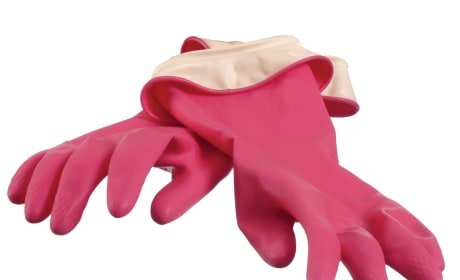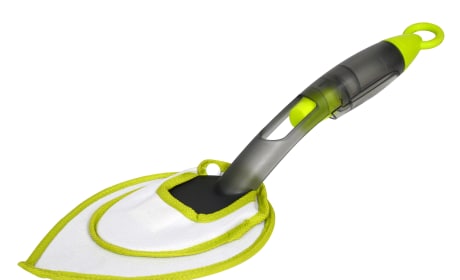How to Clean Copper with Simple Ingredients: Our Tips
Nicole AustinCopper can be a beautiful addition to your kitchen — as long as you properly maintain it.
Cleaning copper with simple, inexpensive ingredients is easier than you might imagine, without compromising on results!
You’ll love our tried-and-true methods. Like cleaning a coffee pot with vinegar, we love simple, proven methods for cleaning our homes and cookware.
I personally love knowing that my family isn’t exposed to harsh chemical additives, and using cleaning solutions that are so harmless they’re actually edible makes my mom heart sing!
I think a lot of people live with the misconception that natural or chemical free cleaning isn’t as effective and safe as using commercial cleaning methods, and I can understand why.
We’re bombarded with advertisements, new products, and of course, peer pressure.
All that said, there is a time and a place for different methods of cleaning, and natural cleaners are usually the perfect fit for an average household’s daily needs.
Copper is beautiful, but comes with some medium-maintenance requirements to keep it from tarnishing.
You probably have noticed over time that copper can corrode and pit if not properly cared for.
To enjoy the full, luxurious beauty and benefits of copper products or displays in your home, you will need to take special care when cleaning copper.
What is the Easiest Way to Clean Copper?
Good news — the easiest way to clean copper is the gentlest.
Oxidation can change the color, shape, and usability of copper, making it look dingy and unappealing. (Unless you’re going for that green Statue of Liberty look!)
Your first instinct might be to attack this onslaught of ugliness with any and all methods on hand, but the fact is, you can make it much worse.
The most effective way to clean tarnished copper is using acid — and though we’re conditioned to think of acid as extremely harsh or dangerous, the fact is that acid exists in nature!
Did you ever soak a penny in ketchup as a child, only to remove it and find it shiny and looking brand new?
Well, that’s exactly the same principle behind our foolproof copper cleaning method.
And anyone who has ever done this knows ketchup is not the easiest way.
Unless, of course, you have access to vats of ketchup and don’t mind cleaning afterward.
Our best practice method for removing tarnish and bringing your copper pieces back to life is a simple, two-ingredient mixture of fresh lemon and salt.
What Cleans Copper the Fastest?
Our favorite method of lemon and a little salt will bring your copper item back to life within minutes.
This natural method is one of our favorite things to share because it's such a simple and easy way to restore any copper surface.
Prepare your copper by washing it first with soapy water to remove grease, dirt, and film from the surface.
Using a soft sponge will prevent any damage to the surface.
To efficiently clean your copper after you have prepared it, we recommend making a paste of two parts salt to three parts lemon juice.
Mix this in a bowl and stir together — if it remains runny, add more salt.
Use a sponge to spread the paste over the copper.
A small, circular motion will help loosen up any debris you missed.
The paste can be left to sit on any areas that have stubborn stains or are heavily tarnished.
Allow to sit for up to 10 minutes at a time, gently scrubbing in intervals to check for effectiveness.
Alternatively, you can find success by cutting a lemon in half and dipping it into salt, using the lemon as a scouring pad and gently squeezing it as you clean.
Slicing off thin layers at a time or adding more salt will keep this cleaning method renewed throughout your cleaning process, and save you a sponge.
It will take a little bit of elbow grease, but it's a great way to restore the entire surface of the copper — and with natural ingredients.
After you have effectively returned the shine to your beautiful copper surfaces, you will want to wipe them down with warm, soapy water and dry immediately.
Use a dry cloth for this — some people prefer to use a microfiber cloth, but you can use a paper towel or other soft cloth in a pinch.
What Should You Not Clean Copper With?
You should definitely not clean copper objects with anything that is overly harsh, abrasive, or damaging.
Bleach is especially terrible for copper, as it will cause corrosion and pitting that will permanently affect the quality and appearance.
Do not place copper cookware in a dishwasher — harsh chemicals used in dishwasher solutions will shorten the lifespan of copper cookware and fill you with regret when you see your beautiful shine diminish!
Warm water and dish soap may sound too simple, but it’s a great regular cleaning approach.
Soft sponges will prevent surface damage and still effectively remove any grease or foreign materials.
Drying copper after cleaning of any kind is essential.
Copper should not be left soaking or sitting wet after use as this will introduce or speed up any oxidation.
Dry copper is happy copper — and happy copper is beautiful! Use a clean cloth on your copper goods.
Can You Clean Copper with Vinegar?
The short answer is yes, you can, and it is an excellent way to remove the tarnish and stains left behind after regular use or neglect.
Vinegar is an affordable, easy to store, safe way to clean copper.
In fact, ketchup contains large amounts of vinegar, which is why it works so well at removing tarnish.
You can replace lemon juice in the paste recipe with distilled white vinegar.
Some people may opt to add baking soda, which will fizz, to enhance the cleaning properties of vinegar paste.
More stubborn areas will benefit from the addition of baking soda before allowing it to set.
Vinegar is also an excellent way to create a soak for items that are heavily tarnished or that need to be cleaned in bulk.
Less expensive and more readily available in large amounts, distilled white vinegar added to a large pot (three parts water, one part vinegar) and heated to a boil makes a very effective soaking vat for your copper product.
When using this boil method, do not leave your pot unattended — you will want to turn off the heat source as soon as the tarnish falls away from the copper.
Then, leave the copper in the cleaning solution until it cools to the touch.
Next, you will want to create one of the above pastes, and clean and dry as previously recommended.
Another benefit of using vinegar is that it’s great for cleaning kitchen appliances, too!
Putting the Pieces Together
For typical tarnish and maintenance, the most efficient natural cleaner for copper is lemon juice, as the acidity is higher than vinegar.
For heavy, hard-to-remove tarnish, boiling your copper in vinegar and water and then cleaning with the paste of your choice is the most effective method.
The hot water and vinegar work together to better restore the surface of the metal and remove copper tarnish.
Tip: Prevent severe or premature tarnishing by keeping copper stored in a cool, dry place. You can also slow the tarnishing process by applying a thin layer of mineral oil immediately after cleaning.
While copper is slightly more high maintenance than other materials, the beauty and efficiency is well worth the extra effort and occasional touch up!
Without compromising health or safety, you can enjoy the brilliance of clean, brilliant copper on your Moscow mule mugs, gorgeous pots, and more.
Nicole is a self-published author of fiction novels, and a lover of food and spending time in the kitchen with her six children. She lives in coastal Maine where she loves exploring new recipes especially those that can save time, money and wow a crowd.









